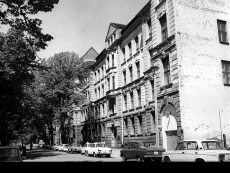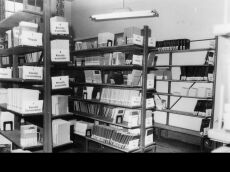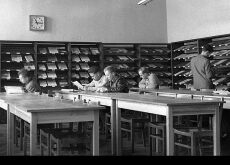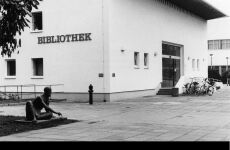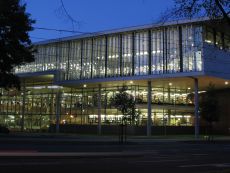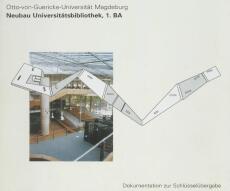History
The University Library of the Otto-von-Guericke University Magdeburg was created by merging the former libraries of the Technical University, the Pedagogical University of Applied Sciences, and the Medical Academy in 1993. The basis for that was the dissolution of the Magdeburg Pedagogical University of Applied Sciences on March 31, 1993, of which the Technical University became the legal successor, as well as the merging of the Technical University and the Medical Academy to form the Otto-von-Guericke University on October 3, 1993.
The Library of the Technical University started its work in the buiding "Am Krökentor 2" as the library of the University of Applied Sciences for Heavy Machine Engineering. In November 1953, Mr. E. Heinz, who later became director of the library, was comissioned to set up a library. He was not able to rely on existing book or journal holdings, and there were no specialist libraries in the city which would have been able to take over the function of an university library.
One of the most important initial tasks was to support the first enrolled students with necessary literature for their basic training, which began on March 3, 1954.
In the following years, the library continued to grow, in terms of its stock, number of users as well as number of employees. This development was accompanied by a step-by-step expansion of the rooms in building "Am Krökentor 2". With the award of the status of Technical University of Applied Sciences on May 10, 1961, the library gained further importance.
The first branch library was established in 1969 for the field of machine engineering. This was followed by branch libraries for the fields of apparatus and plant engineering, social sciences, electrical engineering/electronics as well as materials science. In 1970, the scientific information department was established, and in 1972 the patent display office was expanded into an information center for standards.
Problems arose for the university library in the mid-1970s. By the end of 1976, the stock had grown to almost 170,000 volumes, and more than 2,000 current journal titles were available to users. For lack of space, magazines were provisionally set up in the wide corridors. This led to a high load on the ceiling and, in connection with damage to comparable ceilings in other buildings, resulted in the necessity to gradually release the rooms. From the end of 1979, the old canteen was partly available for use by the library.
At the beginning of 1983, the governmental building inspectorate ordered a change of use for the library rooms remaining in the building "Am Krökentor 2". This finally determined the relocation of the areas of the university library still housed there. The relocation took place at the end of May 1983, after additional rooms had been provided in the old canteen and half a floor in the dormitory 6, which had been prepared as far as possible.
In 1982, the first considerations were made to set up a polytechnic patent library. On September 20, 1984 it was handed over for use as an area of the university library.
In 1987, the Technical University of Applied Sciences Otto-von-Guericke received the status of a Technical University. This was accompanied by a change in the status of the university library. However, further changes were initially not connected with this.
The Medical Academy Magdeburg was founded in 1954. At that time, the clinics and institutes already had a stock of scientific literature. The development of a textbook collection was started immediately. The establishment of a central scientific library, whose first director was Mrs. E. Thiede, took place from 1959 in the building of the central lecture hall.
In 1969, the central scientific library became the first Medical District Library in the German Democratic Republic on the basis of a municipal contract. Thus, It was responsible for the supply of literature and information to the health care institutions in the former district of Magdeburg as well as for the professional guidance of the employees in the medical libraries of this territory.
At the beginning of the 1970s, the Central Library began to set up a scientific information department.
In 1985, the library moved from the central lecture hall building to the new canteen building.
A cooperation agreement on librarian cooperation between the Medical Academy as well as the Institute of Neurobiology and Brain Research of the Academy of Sciences of the GDR was concluded in 1987.
The history of the library of the Pedagogical University of Applied Sciences is closely connected with the development of its supporting institution, which has evolved from an Institute for Teacher Education via an Pedagoical Institute to a Pedagogical University of Applied Sciences.
The year 1963 was established as the founding year of the library. When the University of Applied Sciences was founded, the library had already existed for ten years as an institute library. From this, the university library gradually developed. Its first director was Mrs Schöning.
The university library was located in the teaching building I at Brandenburger Straße 9. In the building of the former art and trade school, which was built in 1920, the library management, acquisitions and user facilities were housed. A second user area was located in the teaching building II in Julius-Bremer-Straße 23 (today Stresemannstraße). This building also housed a microfilm department.
The establishment of a scientific information department was started in 1981.
Important changes took place in 1985, when the library was set up as an open stacks library in the course of a comprehensive renovation of the rooms.
In the course of the political turnaround starting in the end of the 1980s, the three university libraries of Magdeburg also underwent extensive changes. On the one hand, the number of employees was gradually reduced, questions about job retention determined the thinking of the employees to a considerable extent, on the other hand, the tasks became more complex and in some cases were completely different from before.
In 1993, the merger of the three university libraries of Magdeburg mentioned in the beginning was conducted to form the University Library. The University Library of the Technical University became the Main Library, the University Library of the Pedagogical University of Applied Sciences became the Faculty Library for Social, Cultural and Educational Sciences and the Central Library of the Medical Academy became the Medical Central Library.
The time after the merging of the libraries was characterized by construction activity and the further use of information technology (IT).
First, a temporary solution was created in 1993/94 to house the Faculty Library for Social, Cultural and Educational Sciences. In 1994, the expansion of the Central Medical Library, which had become indispensable, could be started step by step. From 1995 to 1997, the Main Library was reconstructed. The new building of the University Library was constructed between 1999 and 2003, the official opening took place on October 1, 2003.
The use of IT in the subsequent years has played an important role. The need to modernize systems and processes on the one hand, and the rapid development of technology itself on the other hand have placed high demands on the library, but have also opened up many new possibilities in supporting its processes and users.
From early on, the question of a library network was discussed in Saxony-Anhalt. Since an own network seemed not to be suitable and could not be realized due to lack of resources, a connection to the Lower Saxony network was planned after examination of possible variants.
After switching to the Dutch PICA software in the Lower Saxony/Saxony-Anhalt network in 1993, three local library systems were gradually set up in Saxony-Anhalt, one of them in Magdeburg, which is used by the Main Library and the Medical Central Library. At first, the Faculty Library still worked with allegro-C, but later it also switched to PICA. Step by step, the individual PICA modules were introduced for all areas of the University Library. The introduction of the PICA system was completed in September 1998, when the loan system in the Faculty Library went live.
The Lower Saxony/Saxony-Anhalt network has developed enormously in the last years. After the accession of Thuringia, it merged with the former North German Network, consisting of the federal states of Bremen, Hamburg, Mecklenburg-Western Pomerania and Schleswig-Holstein, on the basis of an administrative agreement between the participating states. The network was given the name Common Library Network (GBV).
